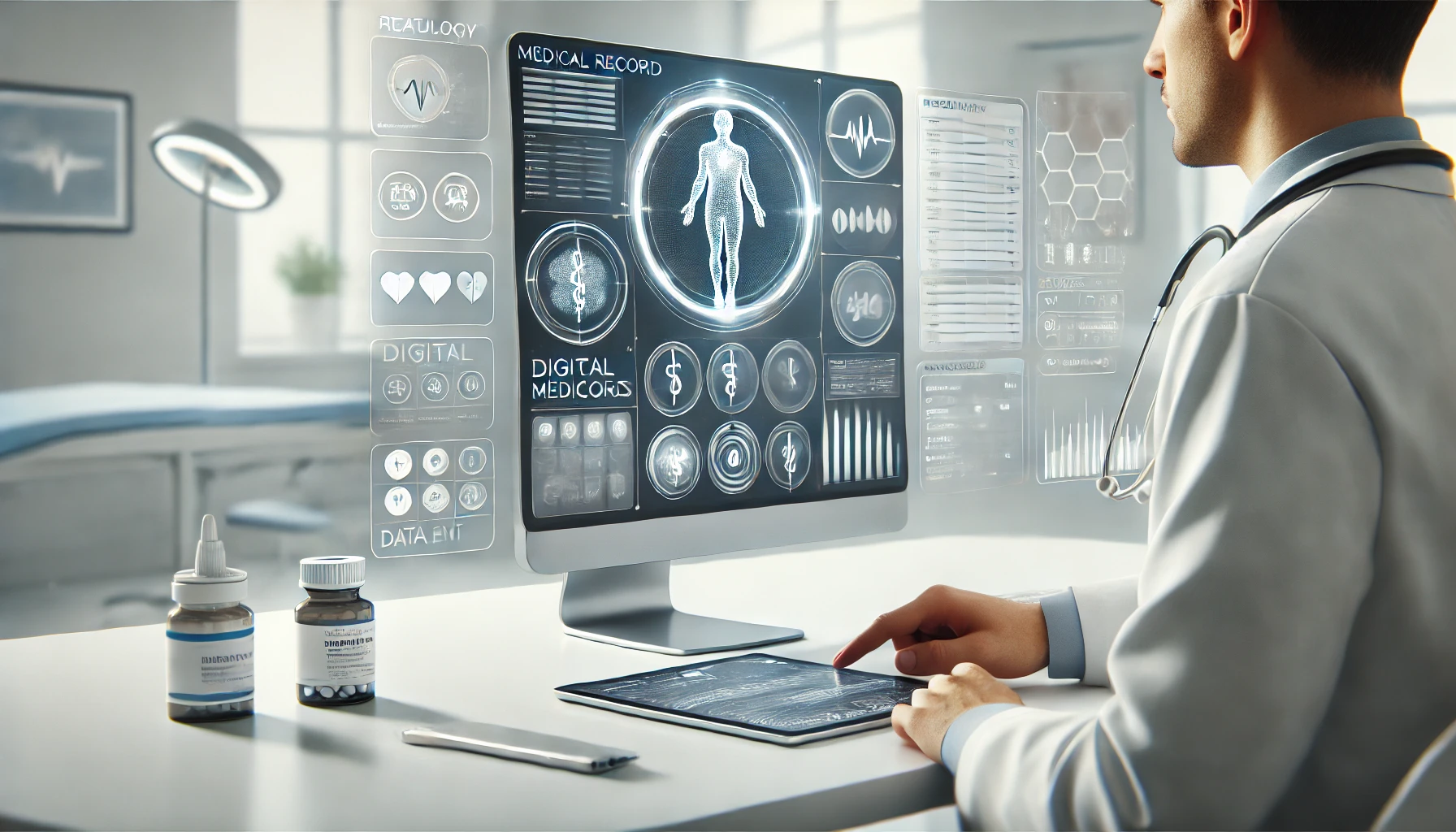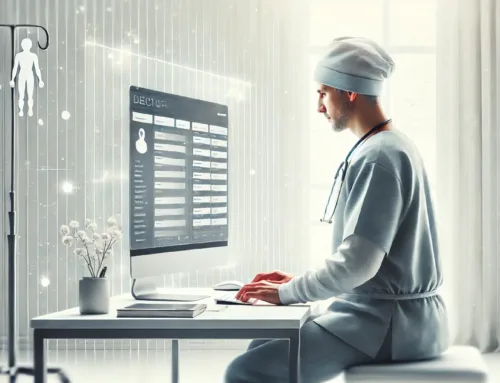In the intricate tapestry of healthcare, technology threads its way through the fabric of medical record data entry, weaving together precision and efficiency. You may be surprised to learn how electronic health records, medical coding software, voice recognition technology, data entry automation, and other innovative tools are transforming the landscape of healthcare documentation. These advancements not only streamline processes but also elevate patient care standards. Whether you’re a healthcare professional or simply intrigued by the intersection of technology and medicine, exploring these ten remarkable ways technology influences medical record data entry is sure to broaden your understanding of the modern healthcare landscape.
Electronic Health Records
When entering data into electronic health records (EHR), it is crucial to ensure accuracy and completeness. Data interoperability is key in ensuring that information can seamlessly flow between different systems, allowing healthcare providers to access patient data efficiently. Integration of telemedicine into EHR systems has revolutionized healthcare delivery, enabling remote consultations and monitoring. By incorporating telemedicine integration, healthcare providers can offer more convenient and accessible care to patients, especially in remote or underserved areas.
Ensuring data interoperability within EHR systems is vital for healthcare facilities to provide comprehensive and coordinated care to patients. It allows for the sharing of patient information across different healthcare providers and systems, leading to better-informed decision-making.
Telemedicine integration enhances the capabilities of EHR systems by enabling real-time communication between healthcare providers and patients. This integration facilitates virtual consultations, remote monitoring, and the exchange of medical information, ultimately improving patient outcomes and satisfaction.
Medical Coding Software
When considering medical coding software, you will benefit from enhanced accuracy in coding, thanks to built-in error checks and validation features. These platforms also offer time-saving automation tools that streamline the coding process, leading to increased efficiency. Furthermore, the integration of medical coding software with Electronic Medical Record Systems (EMRS) facilitates seamless data transfer and ensures consistency in patient records.
Coding Accuracy Benefits
Regular use of medical coding software offers significant benefits in enhancing coding accuracy within medical record data entry. By utilizing advanced algorithms and data validation techniques, medical coding software helps ensure precision and correctness in the coding process.
- Real-time Error Detection: Medical coding software can flag potential errors or inconsistencies in the codes entered, allowing for immediate correction and reducing the likelihood of coding inaccuracies.
- Code Suggestions: These software solutions often provide suggestions for appropriate codes based on the entered information, helping to streamline the coding process and minimize errors.
- Compliance Checks: Medical coding software can perform automatic compliance checks against industry standards and regulations, ensuring that the codes entered meet all necessary requirements for accurate billing and record-keeping.
Time-Saving Automation Features
Enhancing efficiency and accuracy in medical record data entry is further facilitated by the time-saving automation features integrated into modern medical coding software. These features offer streamlined processes by automating repetitive tasks, such as assigning appropriate codes to diagnoses and procedures. By utilizing advanced algorithms, medical coding software can analyze the documentation and recommend accurate codes quickly, reducing the time spent on manual coding.
Time-saving solutions provided by automation features also include the ability to automatically update code sets and rules, ensuring compliance with the latest industry standards. This eliminates the need for manual updates and reduces the risk of errors due to outdated information. Additionally, automation streamlines the review process by flagging potential discrepancies or missing information, allowing coders to focus on resolving specific issues rather than combing through entire records.
Integration With EMRS
To streamline the process of medical record data entry, integration with Electronic Medical Record Systems (EMRS) plays a crucial role in enhancing efficiency and accuracy. When it comes to EMR integration, there are challenges to overcome, but the benefits are substantial. Here’s how integrating with EMRS can improve your data entry workflow:
- Seamless Data Transfer: EMR integration allows for seamless transfer of patient information between systems, reducing the need for manual data entry and minimizing errors.
- Real-Time Updates: Integration with EMRS enables real-time updates to patient records, ensuring that the most current information is always available for accurate coding and billing.
- Enhanced Accuracy: By linking medical coding software with EMRS, accuracy in coding and documentation is significantly improved, leading to better patient care and streamlined administrative processes.
Overcoming EMR integration challenges can lead to significant data entry workflow improvements, making the process more efficient and error-free.
Voice Recognition Technology
Utilizing voice recognition technology in medical record data entry streamlines the process by allowing healthcare professionals to dictate patient information directly into the system. Speech recognition accuracy is a crucial factor in the effectiveness of this technology. Advances in voice recognition software have significantly improved accuracy rates, enabling more precise transcription of spoken words into text. However, challenges in implementation, such as background noise interference or variations in accents and speech patterns, can still affect the overall performance.
To address these challenges, healthcare facilities must invest in high-quality voice recognition systems that undergo continuous training to adapt to various voices and dialects. Additionally, providing proper training to healthcare professionals on how to use the technology effectively can enhance speech recognition accuracy. Despite the implementation challenges, voice recognition technology remains a valuable tool in medical record data entry, offering efficiency and accuracy in capturing patient information.
Data Entry Automation
Automating data entry processes can significantly boost efficiency by streamlining tasks and reducing manual input time. This automation also plays a crucial role in ensuring the accuracy of medical records, minimizing the risk of errors that could impact patient care. By leveraging technology for data entry automation, healthcare providers can enhance workflow efficiency and maintain precise and reliable medical records.
Efficiency Through Automation
Enhancing the efficiency of medical record data entry is crucial in streamlining healthcare processes. With data entry automation, you can significantly improve productivity and streamline operations. Here’s how:
- Reduced Manual Errors: Automation minimizes the risk of human error, ensuring data accuracy and completeness.
- Faster Processing: Automated systems can input data at a much faster rate than manual methods, saving time and increasing productivity.
- Integration Capabilities: Automation tools can seamlessly integrate with existing systems, allowing for a more cohesive workflow and streamlined processes.
Accuracy in Data
To ensure the utmost accuracy in medical record data entry, leveraging automated systems is imperative. Data validation tools within these systems play a crucial role in verifying the integrity and correctness of entered information. By implementing data validation protocols, errors such as missing information, incorrect formats, or inconsistencies can be automatically flagged for review. This proactive approach not only minimizes the occurrence of inaccuracies but also enhances the overall quality and reliability of the stored data.
Moreover, automated systems excel in error detection by promptly identifying discrepancies or anomalies in the entered data. Through predefined algorithms and validation rules, these systems can swiftly pinpoint inaccuracies and highlight them for correction. This real-time error detection capability significantly reduces the likelihood of erroneous data being integrated into the medical records, ultimately enhancing the precision and credibility of the information within the system.
Health Information Exchange
Facilitating the seamless exchange of health information among different healthcare providers, Health Information Exchange (HIE) plays a vital role in enhancing patient care coordination and improving overall healthcare outcomes.
- Interoperability Challenges: HIE addresses the difficulties in ensuring different systems can communicate effectively, enabling the secure exchange of patient data.
- Data Exchange Protocols: HIE utilizes standardized protocols to govern how information is transmitted, ensuring compatibility and security across various platforms.
- Enhanced Care Coordination: By allowing healthcare providers to access comprehensive patient records, HIE promotes better-informed decision-making and coordinated care delivery.
Through overcoming interoperability challenges and adhering to data exchange protocols, HIE streamlines communication between healthcare entities. This efficient exchange of information ultimately leads to improved patient care, reduced duplication of tests, and enhanced overall healthcare quality.
Data Quality Control Tools
When it comes to maintaining the accuracy and integrity of medical record data, error detection software plays a crucial role. Automated data validation tools are also essential for ensuring that information entered meets predefined criteria and standards. These data quality control tools help minimize errors and inconsistencies in medical records, ultimately improving the overall quality of patient care.
Error Detection Software
Error detection software plays a crucial role in ensuring the accuracy and reliability of medical record data entry. This tool is essential for error prevention and maintaining data accuracy throughout the entry process. Here are some key points to understand its significance:
- Real-time Validation: Error detection software provides real-time validation checks, instantly flagging any discrepancies or inconsistencies in the data as it is being entered.
- Quality Control: By implementing error detection software, healthcare providers can ensure that the information entered meets the required quality standards, reducing the chances of errors slipping through unnoticed.
- Enhanced Data Accuracy: With the ability to detect errors promptly, this software contributes to enhanced data accuracy, leading to better decision-making based on reliable information.
Utilizing error detection software not only improves the efficiency of medical record data entry but also plays a vital role in maintaining the integrity of patient records.
Automated Data Validation
Automated data validation tools are essential components in the process of ensuring the accuracy and reliability of medical record data entry. These tools, such as automated data verification systems, play a vital role in optimizing data entry processes. By automatically checking for errors, inconsistencies, and missing information in real-time, these tools help to maintain data integrity and quality control.
Automated data validation tools work by analyzing the input data against predefined rules and criteria. They flag any discrepancies or anomalies, allowing for immediate correction and preventing inaccurate information from being stored in the medical records. This not only enhances the efficiency of data entry but also minimizes the risk of errors that could impact patient care and treatment outcomes.
Through the use of automated data validation, healthcare providers can streamline their data entry processes, reduce manual verification efforts, and improve overall data quality. By integrating these tools into their systems, healthcare organizations can ensure that their medical record data is accurate, complete, and reliable.
Patient Identification Systems
Patient Identification Systems play a crucial role in ensuring accuracy and efficiency in medical record data entry. These systems utilize advanced technologies to streamline the patient identification process, reducing errors and enhancing patient safety. Here are some key points to consider:
- Biometric patient verification: Implementing biometric identification methods such as fingerprints or iris scans helps ensure that the right patient’s information is accessed and updated accurately.
- Data entry training: Providing comprehensive training on data entry processes and the proper use of patient identification systems is essential to minimize errors and maintain data integrity.
- Enhanced security measures: Patient identification systems offer enhanced security features like two-factor authentication, ensuring that only authorized personnel can access and update patient records.
Medical Transcription Tools
Medical transcription tools play a pivotal role in converting spoken words into written text accurately and efficiently within healthcare settings. These tools utilize speech recognition technology to transcribe dictations from healthcare professionals into electronic health records (EHRs) or other documentation. The use of speech recognition not only speeds up the documentation process but also reduces the risk of human error, enhancing data accuracy in medical records.
Health Data Analytics
To further enhance the efficiency and insights derived from medical record data entry, the utilization of health data analytics plays a pivotal role in extracting valuable information for decision-making and improving patient outcomes.
- Data Visualization: Health data analytics utilizes advanced visualization techniques to present complex medical data in easy-to-understand visual formats, aiding healthcare professionals in identifying trends and patterns.
- Predictive Analytics: Through predictive analytics, health data analytics can forecast potential health issues or outcomes based on historical data, enabling proactive interventions and personalized patient care.
- Enhanced Decision-Making: By leveraging health data analytics, healthcare providers can make data-driven decisions, leading to improved treatment plans, resource allocation, and overall healthcare delivery.
Health data analytics empowers healthcare organizations to harness the vast amounts of medical data available, transforming it into actionable insights that drive better patient outcomes and operational efficiency.
Confidentiality and Security Software
When it comes to securing sensitive medical information, confidentiality and security software are essential components in safeguarding patient data from unauthorized access and breaches. Confidentiality measures ensure that patient information is only accessible to authorized personnel, while security protocols protect against cyber threats and data breaches. Advanced encryption techniques are commonly used to secure medical records, ensuring that data is transmitted and stored securely. Access controls and authentication mechanisms further enhance the security of medical data, limiting access to only those with the necessary permissions. Regular security audits and updates help to identify and address potential vulnerabilities in the system, ensuring ongoing protection of patient information. By implementing robust confidentiality measures and security protocols through specialized software, healthcare providers can maintain the privacy and integrity of medical records, building trust with patients and complying with regulatory requirements.
Frequently Asked Questions
How Does Technology Ensure Patient Data Privacy?
Just like a fortress protecting its treasures, technology ensures patient data privacy through data encryption, which scrambles information, and access control, which restricts who can view or modify sensitive medical records, safeguarding confidentiality.
What Are the Common Challenges in Data Entry Automation?
Data accuracy is crucial in data entry automation. Challenges often arise due to staff training gaps. Ensuring proper training for staff can improve accuracy and efficiency in automated data entry processes, leading to better overall data quality.
Can Voice Recognition Technology Prevent Errors?
Can voice recognition technology prevent errors? Absolutely! Voice recognition tech is a game-changer in error prevention. By accurately transcribing spoken words into text, it minimizes human-induced mistakes. Additionally, it boosts data security through biometric authentication features.
How Do Medical Transcription Tools Improve Efficiency?
Medical transcription tools improve efficiency by enhancing productivity through automated data entry and improving accuracy with advanced error detection algorithms. By streamlining the process, these tools save time and reduce the risk of mistakes in medical records.
What Measures Are in Place for Data Quality Control?
To ensure data accuracy, advanced algorithms and regular audits are employed for data validation. A striking 98% accuracy rate is achieved through automated checks and manual reviews, maintaining high data quality control standards in medical record data entry.




